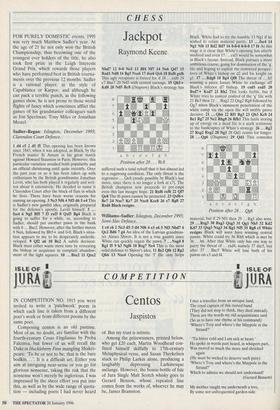CHESS
Jackpot
Raymond Keene
FOR PURELY DOMESTIC events, 1995 was very much Matthew Sadler's year. At the age of 21 he not only won the British Championship, thus becoming one of the youngest ever holders of the title, he also took first prize in the Leigh Interests Grand Prix, which rewards those players who have performed best in British tourna- ments over the previous 12 months. Sadler is a rational player, in the style of Capablanca or Karpov, and although he can pack a terrible punch, as the following games show, he is not prone to those weird flights of fancy which sometimes afflict the games of his grandmaster colleagues such as Jon Speelman, Tony Miles or Jonathan Mestel.
Sadler–Regan: Islington, December 1995; Clarendon Court Defence.
1 d4 c5 2 d5 f5 This opening has been known since 1843, when it was adopted, as Black, by the French master St Amant in his great match against Howard Staunton in Paris. However, this particular variation avoided both popularity and an official christening until quite recently. Over the past year or so it has been taken up with enthusiasm by the British grandmaster Jonathan Levitt, who has both played it regularly and writ- ten about it extensively. He decided to name it Clarendon Court after the block of flats in which he lives. There have been worse reasons for naming an opening. 3 Nc3 Nf6 .4 Nf3 d6 5 e4 This is Sadler's new gambit idea, originally prepared for the defence's apostle, Levitt himself. 5 ... fxe4 6 Ng5 Bf5 7 f3 ext3 8 Qx13 Bg4 Black is going to suffer for a while, so, according to Sadler, should put another pawn in the bank with 8 ... Bxc2. However, after the further moves 9 Ne6, followed by Bb5+ and 0-0, Black's situa- tion appears to me to be desperately underde- veloped. 9 Qf2 a6 10 Be2 A subtle decision: Black must either waste more time by retreating the bishop or acquiesce in complete abandon- ment of the light squares. 10 ... Bxe2 11 Qxe2
Nbd7 12 0-0 Ne5 13 Bf4 Nf7 14 Ne6 Qd7 15 Radl Nd8 16 Bg5 Nxe6 17 dxe6 Qc6 18 Bxf6 gxf6 This ugly recapture is forced for if 18 ... exf6 19 e7 Bxe7 20 Nd5 with central carnage. 19 QhS+ Kd8 20 Nd5 Rc8 (Diagram) Black's strategy has suffered such a total rebuff that it has almost led to a zugzwang condition. The only threat is the regressive ... Qe8 (made possible by Black's last move, since there is no longer a fork at c7). The British champion now proceeds to pre-empt even this last meagre hope. 21 Rxf6 exf6 22 Qf7 Qe8 The f6 pawn cannot be protected. 23 Qxf6+ Bel 24 Nxe7 Kc7 25 Nxc8 KxcS 26 e7 Rg8 27 Rxd6 Black resigns.
Williams–Sadler: Islington, December 1995; Semi-Slav Defence.
1 c4 c6 2 Nc3 d5 3 d4 Nf6 4 e3 e6 5 NE3 Nbd7 6 Qc2 Bd6 7 g4 An idea of the Latvian grandmas- ter Alexei Shirov. It is not a true gambit since White can quickly regain the pawn. 7 ... Nxg4 8 Rgl f5 9 h3 Ngf6 10 Rxg7 Ne4 This is the most solid defence to Shirov's idea. 11 Be2 Qf6 12 Rg2 Qh6 13 Nxe4 Opening the 'f' file only helps
Black. White had to try the humble 13 Ngl if he wished to retain material parity. 13 ...fxe4 14 Ngl Nf6 15 Bd2 Bd7 16 0-0-0 0-0-0 17 f4 At this stage it is clear that White's opening has utterly misfired and even 17 ... exf3 would be somewhat in Black's favour. Instead, Black pursues a more ambitious course, going for domination of the `g' file and hoping to exploit the restricted perspec- tives of White's bishop on d2 and his knight on gl. 17 ...Rdg8 18 Bg4 QfS The threat of ... h5 winning a piece forces White to exchange off Black's inferior d7 bishop. 19 cxd5 exd5 20 Bxd7+ Kxd7 21 Rh2 This looks feeble, but if White tries to contest control of the 'g' file with 21 Bc3 then 21 ... Rxg2 22 Qxg2 Rg8 followed by Qg7 when Black's imminent penetration of the white camp via the open file will swiftly prove decisive. 21 ...Qh6 22 Rfl Rg3 23 Qb3 Kc8 24 Bel Rg7 25 Net Rhg8 26 Itfhl This futile storing up of energy on a dead file is a stark testimony to the bankruptcy of White's strategy. 26 ...Rg2
27 Rxg2 Rxg2 28 Ng3 28 Qdl resists for longer.
28 ...Qg6 (Diagram) 29 Qdl This concedes
Position after 28 . .Qg6
material, but if 29 Nfl then 29 ... Rgl also wins.
29 ... Rxg3 30 Bxg3 Qxg3 31 Qgl Nh5 32 Kd2 Kd7 33 Qxg3 Nxg3 34 Rgl Nf5 35 Rg8 c5 White resigns Black will soon have winning central pawns. White could try 36 Rh8 which is met by 36 ... h6. After that White only has one way to parry the threat of ...cxd4, namely 37 dxc5, but after 37 ... Bxc5 White will lose both of his pawns on e3 and f4.


























































 Previous page
Previous page